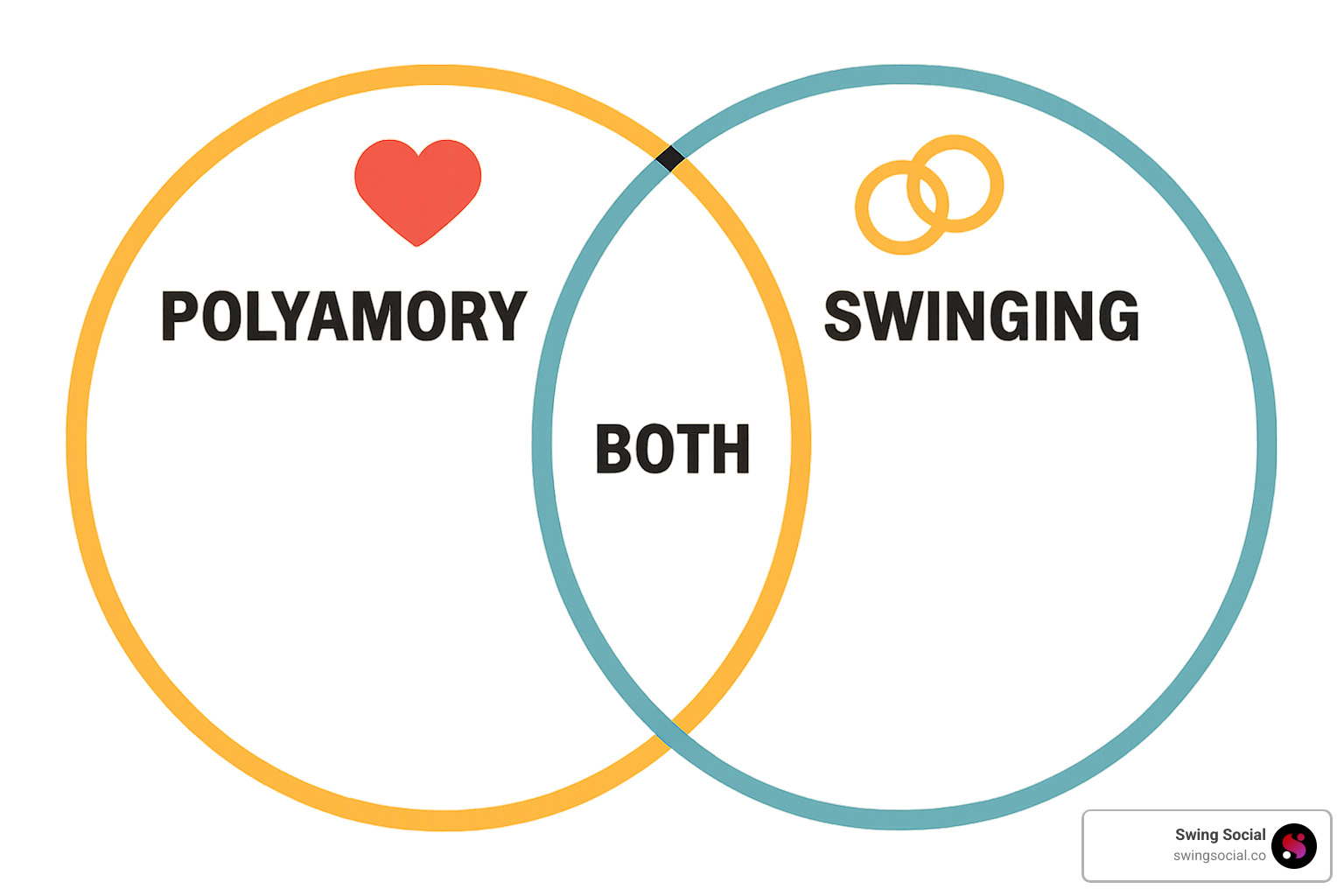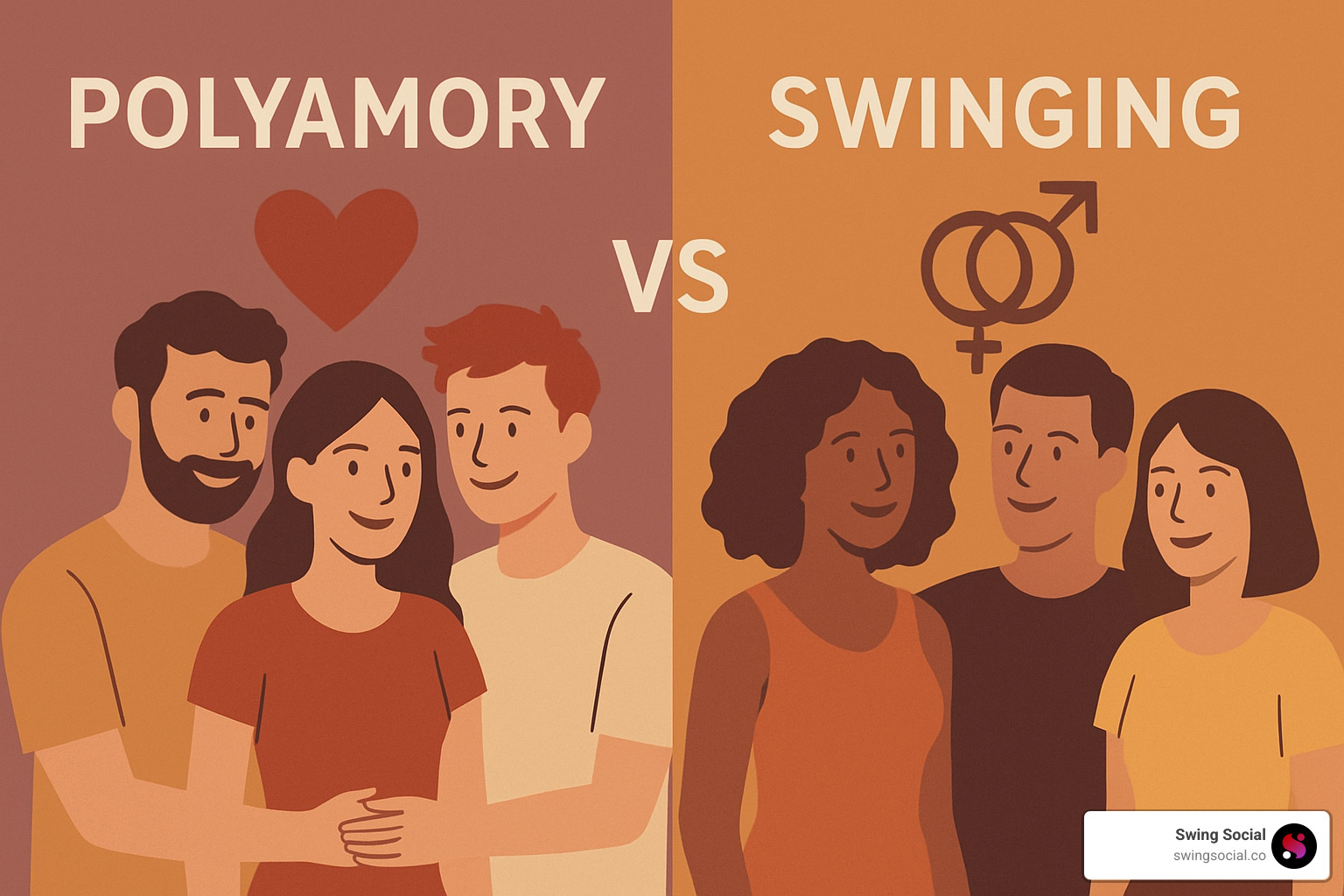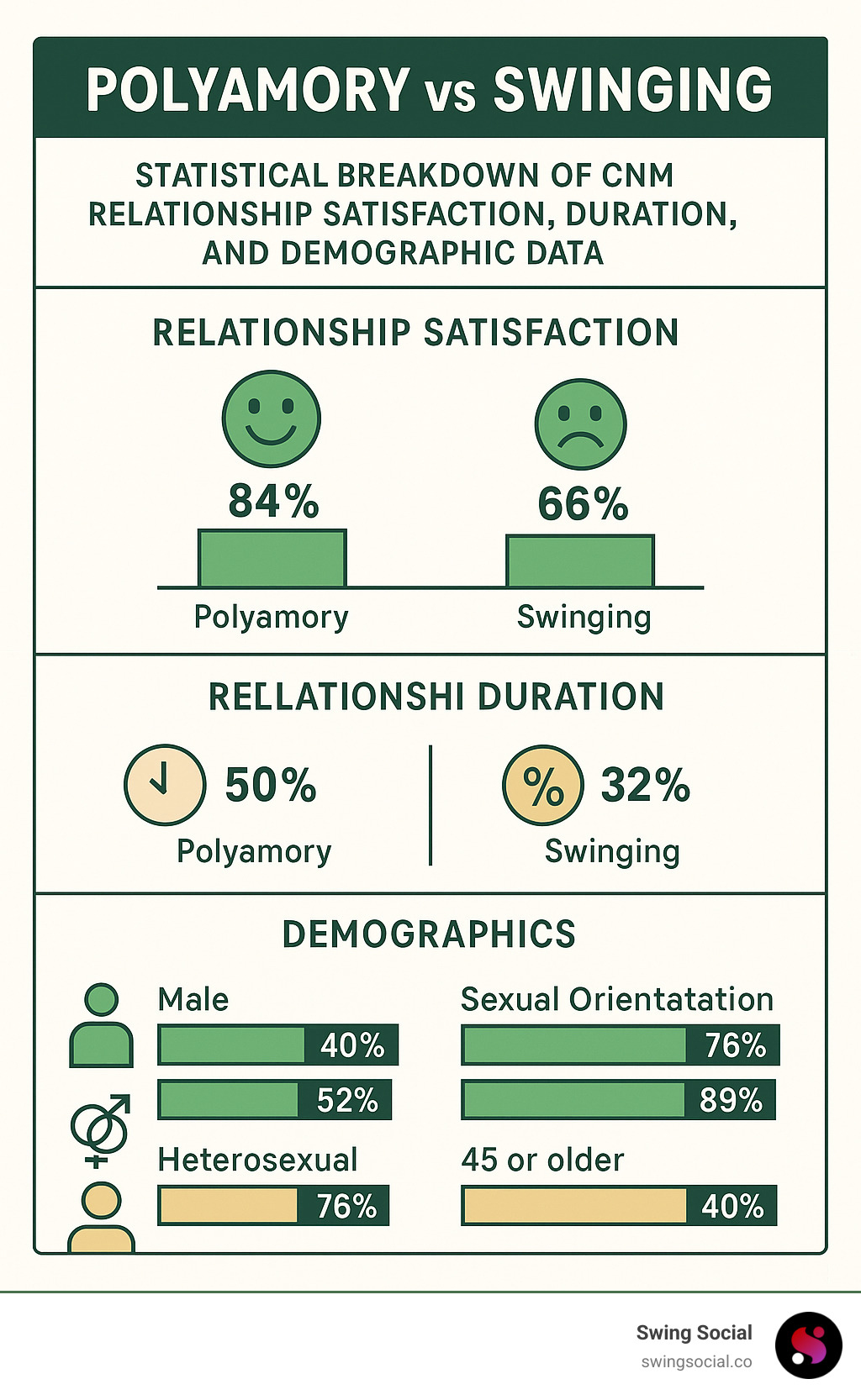Understanding the World of Consensual Non-Monogamy
Polyamory vs swinging represents two distinct paths within consensual non-monogamy, each offering unique approaches to intimate relationships beyond traditional monogamy.
Quick Answer: Key Differences
| Aspect | Polyamory | Swinging |
|---|---|---|
| Focus | Multiple loving relationships | Recreational sex with others |
| Emotional involvement | High – romantic connections encouraged | Low – emotional detachment preferred |
| Typical structure | Individual networks of partners | Couple-based activities |
| Demographics | Often LGBTQ+ and kink-friendly | More conservative and heterosexual |
| Time commitment | Ongoing relationships | Occasional events or encounters |
About 20% of adults have experienced some form of open relationship in their lifetime, with polyamory involving multiple romantic attachments while swinging focuses on sexual encounters without falling in love.
Polyamory means “many loves” – it’s about forming multiple emotionally intimate relationships with full consent from everyone involved.
Swinging is often called “the lifestyle” – it’s recreational sex between couples or singles at parties, clubs, or private gatherings. The emphasis stays on sexual fun rather than romantic feelings.
Both lifestyles require honest communication, clear boundaries, and enthusiastic consent from all parties. Neither is about cheating or deception – they’re ethical alternatives to monogamy.
The main difference? Polyamory welcomes emotional connections while swinging typically avoids them. Polyamory tends to attract more LGBTQ+ individuals and those in kink communities, while swinging draws more heterosexual, gender-normative couples.

Consensual Non-Monogamy 101
Think of consensual non-monogamy (CNM) as the big umbrella that covers all the different ways people create ethical relationships with multiple partners. The key word here is consensual – everyone involved knows what’s happening and agrees to it.
About 4% of U.S. adults are currently in open relationships, but 31% of women and 38% of men say they’d actually prefer non-monogamous arrangements.
You’ll sometimes hear people use “ethical non-monogamy” and “consensual non-monogamy” interchangeably. Ethical non-monogamy focuses on doing the right thing morally, while consensual non-monogamy emphasizes getting clear agreement from all parties.
Both approaches are miles away from cheating. Scientific research on consensual non-monogamy shows that people in CNM relationships often have higher levels of trust, better communication skills, and more sexual satisfaction compared to those who sneak around.
Stigma around non-monogamy is slowly fading, especially among younger people and LGBTQ+ communities. More folks are realizing that there’s no one “right” way to structure relationships.
Where Does Swinging Fit?
Swinging reportedly started with U.S. Air Force pilots after World War II. These guys would engage in “wife swapping” as a way to bond socially.
Today’s swinging scene has evolved into organized “lifestyle” clubs, conventions, and online networks. Many people prefer calling it “the lifestyle” instead of swinging.
Swinging stays couple-centric – partners usually participate together rather than going off on their own. This approach helps protect the primary relationship while allowing sexual exploration.
The swinging community tends to attract more conservative, heterosexual, gender-normative participants compared to other forms of CNM.
Where Does Polyamory Fit?
Polyamory literally means “many loves” – and that’s exactly what it’s about. Unlike swinging’s focus on sexual recreation, polyamory welcomes emotional intimacy and romantic attachment with multiple people.
The polyamory world recognizes different relationship structures. Hierarchical polyamory has primary and secondary partners. Non-hierarchical polyamory treats all relationships as equally important.
These relationship networks often get called “polycules” (think molecule, but for poly relationships). They can become beautifully complex as they grow and change over time.
Polyamory overlaps significantly with LGBTQ+ and kink communities, creating a much more diverse demographic than traditional swinging.
Polyamory vs Swinging: Detailed Comparison

When you’re exploring polyamory vs swinging, it helps to think of them as two different languages of love and connection. Both speak fluently in consensual non-monogamy, but they have completely different vocabularies and cultural norms.
The most striking difference lies in emotional involvement. Polyamory actively encourages deep romantic connections with multiple partners. Swinging takes the opposite approach, creating clear boundaries around emotional attachment while celebrating sexual exploration.
Time investment tells another important story. Polyamorous folks often need a calendar app just to manage their dating life. Multiple ongoing relationships require constant communication and emotional availability. Swingers can enjoy their lifestyle more episodically.
The demographics create distinctly different community vibes. Swinging tends to attract more heterosexual, gender-normative couples. Polyamory meetups feature more diverse crowds with strong LGBTQ+ and kink community representation.
| Factor | Polyamory | Swinging |
|---|---|---|
| Primary motivation | Multiple loving relationships | Sexual variety and excitement |
| Emotional boundaries | Encouraged romantic connections | Discouraged emotional attachment |
| Relationship duration | Long-term partnerships | Casual encounters |
| Community events | Discussion groups, munches | Parties, clubs, conventions |
| Demographics | LGBTQ+ friendly, diverse | Predominantly heterosexual couples |
| Risk profile | Higher emotional complexity | Lower emotional stakes |
Polyamory vs Swinging at a Glance
Polyamory operates on the principle that love multiplies rather than divides. When polyamorous people say “I love you,” they mean it in the full romantic sense. Many view polyamory as an identity rather than just a relationship style.
Swinging maintains a clear distinction between love and sex. Most swingers describe themselves as monogamous in love while being non-monogamous sexually.
The casual versus committed distinction shapes everything from how people meet to how they maintain boundaries. Polyamory welcomes the full spectrum of relationship experiences. Swinging intentionally keeps things light and recreational.
Polyamory vs Swinging in Practice
The real-world differences become clear when you look at how people actually meet and connect. Polyamorous folks often use mainstream dating apps like OkCupid or specialized platforms like Feeld. They attend “munches” – casual coffee shop gatherings focused on conversation and community building.
Swingers connect through dedicated lifestyle websites, private clubs, and organized parties. The emphasis stays firmly on couple-based activities. Swing parties often include hours of socializing before anyone heads to the play areas.
Event types reflect these different priorities. A polyamory meetup might feature a discussion about jealousy management. A swing party includes dancing, flirting, and social time before transitioning to more intimate activities.
The relationship networks that develop look completely different. Polyamory creates complex webs called “polycules” where everyone steers multiple interconnected relationships. Swinging maintains clearer boundaries.
Rules, Emotions, Benefits & Challenges

When exploring polyamory vs swinging, understanding the emotional realities becomes just as important as knowing the basic definitions. Both lifestyles demand excellent communication skills, but they channel those skills in very different directions.
The safer-sex conversation takes on unique flavors in each community. Swingers often create straightforward agreements about condom use, STI testing schedules, and which activities are okay. Polyamorous folks face a more complex puzzle, managing these conversations across multiple ongoing relationships with different agreements for different partners.
Jealousy management represents perhaps the biggest emotional challenge in both communities. Swingers might feel a sharp pang watching their partner at a party, but they know it’s temporary. Polyamorous individuals deal with the ongoing possibility that their partner might fall deeply in love with someone new.
Scientific research on jealousy reveals that successful people in both lifestyles develop specific coping strategies. Swingers often focus on compartmentalizing emotions, while polyamorous individuals work on changing jealousy into compersion – that warm feeling of joy when your partner is happy with someone else.
New Relationship Energy (NRE) hits polyamorous relationships hard. That intoxicating feeling when you first fall for someone happens repeatedly and can temporarily overshadow existing relationships. Swingers largely sidestep this issue since their encounters typically avoid romantic attachment.
Crafting Agreements That Stick
Creating successful agreements isn’t about writing the perfect contract once – it’s about building a living document that grows with your experience.
Swinging agreements typically focus on practical boundaries: Can you play separately or only together? What sexual activities are permitted? These agreements often include veto power – the ability for either partner to end a particular connection if they feel uncomfortable.
Polyamorous agreements dive deeper into time management and emotional boundaries. How much time does each partner get? What information gets shared about other relationships?
The concept of veto power creates heated debates in polyamory circles. Many practitioners argue it creates unhealthy power dynamics, while others see it as essential protection. Swingers generally accept veto power as standard practice.
Renegotiation becomes your best friend in both lifestyles. What feels right when you’re starting out might feel completely wrong six months later.
Emotional Landscape
The emotional terrain of polyamory vs swinging feels like comparing mountain climbing to beach volleyball – both are challenging, but in completely different ways.
Compersion – that magical feeling of joy when your partner is happy with someone else – represents the holy grail of polyamory. Swingers don’t typically focus on compersion since they’re actively avoiding deep emotional connections with others.
Support systems function differently in each community. Polyamorous individuals often create complex networks where multiple partners provide emotional support for each other. Swingers typically maintain their primary relationship as their main emotional anchor.
Pros, Cons & Common Misconceptions
Polyamory’s biggest wins include having multiple sources of love and support, personal growth through diverse relationships, and freedom to express feelings authentically. But it also brings complex time management, potential for increased drama, and social stigma.
Swinging’s major benefits center on sexual variety while protecting your primary relationship and shared experiences that can strengthen couple bonds. The challenges include potential jealousy, limited emotional connections with others, and social stigma requiring secrecy.
The biggest misconception about polyamory? That it’s “just about sex” when it’s actually focused on emotional connections. Swinging faces the opposite stereotype – people assume swingers are “commitment-phobic” when most maintain incredibly strong primary relationships.

Getting Started: Safety, Community & FAQs

Taking your first steps into either polyamory or swinging can feel overwhelming, but both communities welcome newcomers with open arms. The key is starting slowly, prioritizing safety, and connecting with experienced community members.
Finding the right platform makes all the difference when exploring polyamory vs swinging. For polyamory, apps like Feeld and OkCupid allow you to clearly state your relationship style. Swinging takes a more couple-focused approach through dedicated platforms that help you connect with other couples.
Safety protocols become your foundation in both lifestyles. STI testing should happen regularly – many experienced practitioners test every three to six months and share recent results with potential partners. Condom negotiation needs honest discussion before any sexual activity occurs.
Both communities emphasize enthusiastic consent. This means everyone involved genuinely wants to participate, not just agreeing reluctantly. You always have the right to change your mind, slow down, or stop completely.
Finding Your People
Building connections in these communities happens through different channels, but both emphasize genuine relationships over quick hookups.
Polyamory communities often organize munches – casual gatherings in coffee shops where people discuss experiences and build friendships. You’ll also find polyamory discussion groups through LGBTQ+ centers and online forums.
The swinging community thrives on social connections. Meet-and-greets at restaurants or bars let couples connect without pressure for intimate activities. Swing clubs offer another entry point, though most clubs welcome newcomers and provide tours or orientation sessions.
Geography plays a role in community availability. Cities like Miami, Atlanta, and New Orleans – where Swing Social has strong presence – offer numerous options for both lifestyles.
Staying Safe & Consensual
Vetting partners protects both your physical and emotional well-being. In polyamory, this often means extensive conversations about relationship styles and expectations before meeting. Swinging couples typically meet at social events or connect through community referrals before any intimate encounters.
Privacy concerns affect both communities but show up differently. Polyamorous individuals might worry about workplace discrimination, while swingers often maintain strict privacy about their lifestyle activities.
Testing and protection requires ongoing attention. Establish clear protocols with all partners about testing frequency, sharing results, and safer-sex practices.
Frequently Asked Questions about polyamory vs swinging
Can someone be both polyamorous and a swinger?
Absolutely! The “poly-swinger” identity is more common than you might think. Some polyamorous individuals enjoy attending swing parties for casual encounters while maintaining their ongoing romantic relationships.
Identity fluidity means your preferences might evolve over time. The overlap between communities creates natural bridges. Both emphasize consent, communication, and ethical behavior.
How do jealousy and communication differ in polyamory vs swinging?
Jealousy management strategies differ significantly between these lifestyles. Polyamorous individuals often work to transform jealousy into compersion through therapy, self-reflection, and community support. Swingers might experience jealousy during encounters but often find it easier to manage due to the temporary nature of their activities.
Ongoing vs episodic communication reflects the different relationship structures. Polyamory requires constant relationship management across multiple partners, while swinging allows for more focused communication around specific events.
What should I consider before choosing a style?
Goals and desires matter most. If you want multiple romantic relationships and enjoy complex emotional connections, polyamory might appeal to you. If you prefer sexual variety while maintaining one primary romantic relationship, swinging could be a better fit.
Bandwidth considerations include your available time, energy, and emotional capacity. Partner alignment is crucial for success – both lifestyles require enthusiasm from everyone involved.
Conclusion
The journey through polyamory vs swinging reveals two beautiful but distinct paths for those seeking alternatives to traditional monogamy. Neither lifestyle is “right” or “wrong” – they simply serve different hearts and different dreams.
If you’re someone who believes love multiplies rather than divides, polyamory might call to you. It offers the chance to build multiple meaningful relationships, each bringing its own joys, challenges, and growth opportunities. For those who thrive on deep connections and emotional richness, polyamory can feel like coming home to yourself.
Swinging takes a different approach – it’s about keeping your heart with one person while exploring physical connections with others. The lifestyle offers excitement, variety, and shared trips that can actually strengthen your primary bond.
Both paths demand the same foundational elements: rock-solid communication, crystal-clear boundaries, and genuine enthusiasm from everyone involved. Neither lifestyle works as a band-aid for relationship problems or a compromise where one partner reluctantly goes along.
The beautiful truth is that these choices aren’t carved in stone. Many people evolve in their relationship styles as they grow and learn about themselves. Some start with swinging and find they want deeper connections. Others begin with polyamory and realize they prefer the simplicity of one romantic relationship with occasional sexual trips.
Take time to really examine your heart. What do you want from relationships? How much time and emotional energy do you have to invest? What makes you feel most fulfilled and authentic?
If the swinging lifestyle sparks your curiosity, Swing Social provides a welcoming community where you can explore safely and connect with like-minded couples. Our platform spans from Miami’s vibrant scene to Atlanta’s friendly community, offering both local connections and travel opportunities for those ready to dip their toes in the lifestyle waters.
There’s no rush to decide anything. Whether you choose polyamory, swinging, or decide that monogamy works perfectly for you, what matters most is honest communication and respect for everyone in your life. Your relationship style should feel like a celebration of who you are, not a compromise of your values.
More info about the swinger lifestyle
